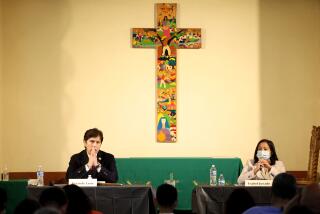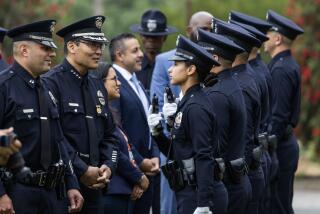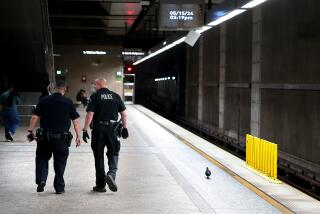Budget Must Find Room to Add 140 Police, City Orders
Two days after declaring that drug- and gang-related violence had created a âstate of emergency,â the San Diego City Council on Thursday ordered City Manager John Lockwood to find the money in next yearâs budget to add 140 police officers and two police substations.
The 9-0 council vote will require Lockwood to cut $10 million from other city departments to pay for the new officers and 46 support personnel needed to back them up.
Even more cuts would be required to acquire land and begin designing the substations, which could cost as much as $3.5 million apiece, and to hire city attorneys and communications personnel to augment the beefed-up police force, Lockwood said.
Lockwood said he hopes to accomplish the spending reductions without laying off city employees but will not rule out the possibility of small cuts in the city work force. Lockwood refused to say Thursday where the cuts might be made, but other city departments include parks and recreation, planning, engineering and development, and libraries.
When added to the 22 new officers already proposed by Lockwood, the council plan would increase the number of officers in the Police Department--the cityâs largest general fund agency--by nearly 10%.
The spending blueprint could put 162 new officers on the street by the end of summer in 1990, Lockwood said. The substations, one of which appears destined for the high-crime intersection at 30th Street and Imperial Avenue--proposed by Mayor Maureen OâConnor in her January State of the City address--could be open within two or three years, according to Councilman Ed Struiksma.
OâConnor said the plan is intended to show Gov. George Deukmejian that the council is serious about its request that he also declare a state of emergency and grant the city $34 million in state aid--a prospect that appeared increasingly dim Thursday. The plan was devised at a private, morning meeting of the âlocal disaster councilâ formed Tuesday after the councilâs emergency declaration.
OâConnor made the highly unusual request for a gubernatorial emergency declaration, traditionally reserved for natural disasters, in a letter to Deukmejian on Tuesday.
âWhat weâre trying to tell the state is that this is serious and weâre cut to the bone,â said OâConnor, who two days ago described the crime crisis as beyond the control of local âservices, personnel, equipment and facilities.â
Mayor Calls Budget âWholly Inadequateâ
On Thursday, she again argued that city funding is âwholly inadequateâ to pay for more jails, courts, prosecutors and other law enforcement needs that total more than $100 million.
A Deukmejian spokesman Thursday issued his most definitive statement yet that the governor has no intention of singling out San Diego for a piece of the stateâs new-found,$2.5 billion budget surplus.
âThere are no plans to proclaim a state of emergency,â said Kevin Brett, Deukmejianâs press secretary. âWhat we have before us is a $34-million budget request that will be decided in the normal budget process.â
Even if the city never receives a dime from Sacramento, the mayorâs emergency declaration appears to have created a political climate in which the council has no choice but to beef up the police force at almost any cost to other city priorities. The escalation of rhetoric on drugs and gangs is particularly sensitive for the four council members who face district-only elections for the first time this year.
Earlier in the week, those close to the mayor insisted that her purpose in declaring a state of emergency was solely to get a piece of the state budget surplus. They insisted there was no intention of raising the stakes on the city budget to force the council to spend more money for police.
But, on Thursday, that appeared to be the unintended consequence of her gambit.
The City Council has repeatedly announced its intentions to find the $18.5 million needed for the first year of a three-year, $62.2-million program to increase police coverage from 1.62 officers per thousand residents to two officers per thousand. But the extremely tight fiscal 1989-90 budget Lockwood proposed May 11 actually would have reduced police presence to 1.59 officers per thousand residents.
Though it is impossible to predict whether the council will adopt the new spending plan that Lockwood will suggest to the emergency panel Tuesday, there appears to be very strong support for the 140 new police officers, regardless of the cost to other city departments.
âThereâs no question in my mind that we will have the 140 additional officers,â said Struiksma, who serves on the emergency council with OâConnor, Councilman Wes Pratt, Councilwoman Gloria McColl, Lockwood, City Atty. John Witt and Police Chief Bob Burgreen. âThere is no question in my mind that we will have the resources for two additional substations.â
âI never commit until absolutely the final vote,â OâConnor said. âBut I can tell you there is strong support for the 140, including myself.â
A fifth vote could come from Councilman Bob Filner, who has repeatedly said he would ask the council to cut its budget deeply to put more officers on the street.
âI was the one who brought up that we ought to tighten our own budget,â he said Thursday. âIâm glad that they finally agreed with it.â
2 Per 1,000 People
An additional 140 police officers would be almost one-third of the 440 needed to bring the city police force to two officers per thousand people over three years. Still, Burgreen cautioned, added manpower wonât curb the crime rate if there is no new jail space to house offenders.
The chief said, â140 new officers and two new substations really would help us to increase service to the community.â
âIf we can convince the state about the seriousness of the jail crisis in San Diego, then we could really begin to show some progress in our fight against the growing crime problem.â
To reinforce the seriousness of their request for emergency state aid, council members told Lockwood and Witt to ask the county Board of Supervisors, Sheriff John Duffy and Dist. Atty. Edwin Miller for help in devising a spending plan for the $34 million.
OâConnor also plans to meet with Bush Administration drug czar William Bennett in an attempt to win federal support for the cityâs drug-related law enforcement needs.
Near 30th, Imperial
Although the first substation sought by the council is expected to go near 30th and Imperial, police would like the second substation near 40th Street and University Avenue, which would be roughly between the two large and overburdened Southeastern and Eastern police divisions, police spokesman Dave Cohen said.
âIt would make sense to place something in that widespread area to cut off some of the police travel response times and the sizeâ of the existing patrol divisions, Cohen said. âSoutheastern has a large area to cover, as does Eastern, and itâs a high-density population area there.â
Pratt suggested that the second substation could go somewhere in mid-city or on East Mesa; Struiksma suggested that it would be placed in mid-city.
Lockwood said money for the substation would come from his proposed $260-million capital improvement budget and would be phased in over the several years required to acquire land and build the facilities. Also uncertain is how large the substations would be, though OâConnor said she hopes the Southeast San Diego facility will be able to house the entire 86-person Special Enforcement Detail targeted at drug- and gang-related crime.
Cuts in the proposed $404.7-million operating budget to finance the additional officers could be difficult. The budget already includes large reductions in park, recreation and library services, and a mandate that city employees provide more services without corresponding budget increases.
More to Read
Sign up for Essential California
The most important California stories and recommendations in your inbox every morning.
You may occasionally receive promotional content from the Los Angeles Times.











